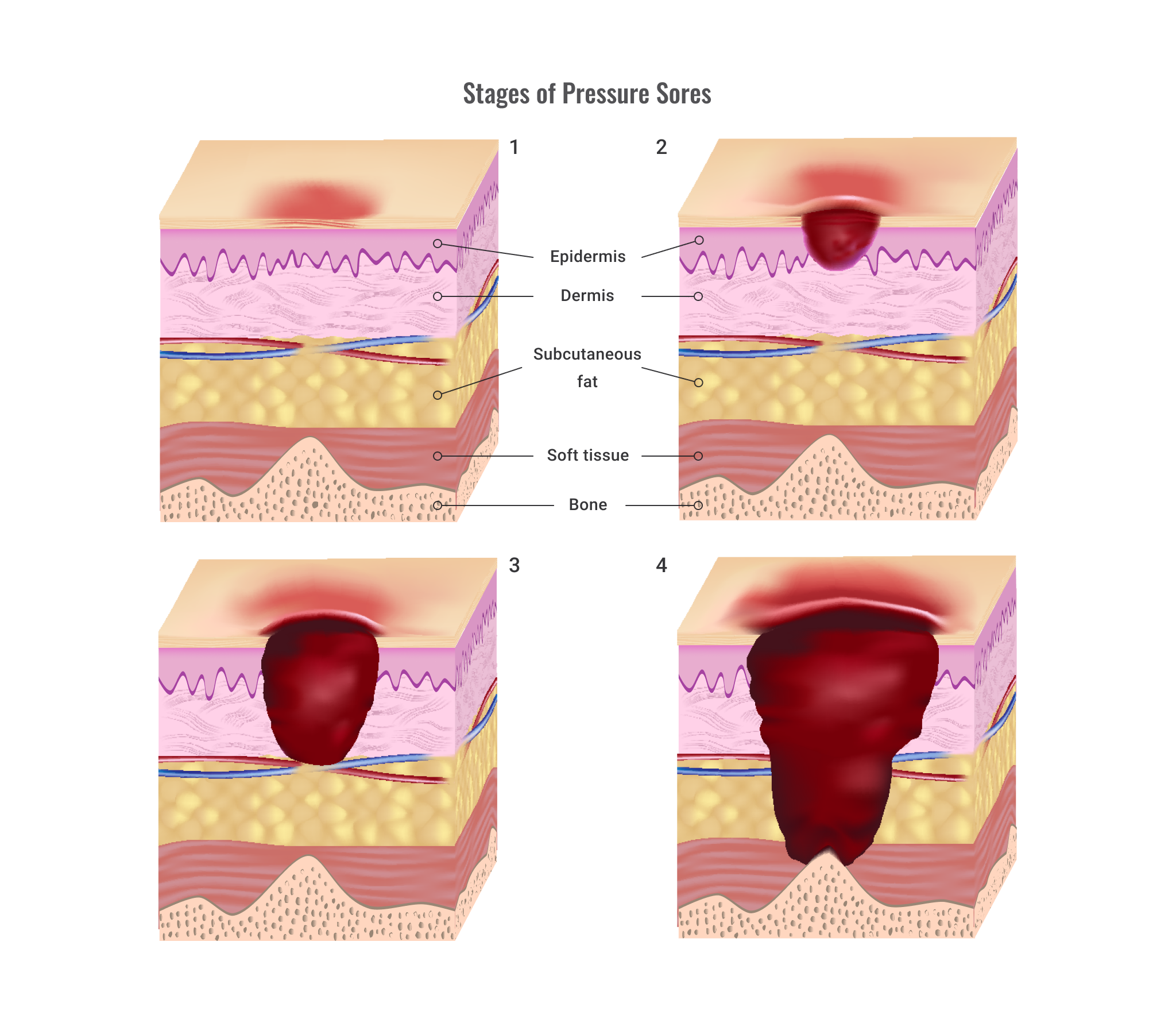What is risk?
Risk is the possibility of danger, harm or abuse occurring. This risk may come from a person's behaviour or from a physical situation. It is the chance that somebody could be harmed, together with an indication of how serious the harm could be.
Examples of risks in support work include:
- The possibility of slipping on spilled liquid and falling
- The risk of overdose from inappropriately accessed medication
- The possibility of being attacked by an unpredictable or aggressive client
- The risk of injury when lifting a client
- The possibility of mental distress due to workplace bullying, stress or fatigue.
Risks and hazards
A hazard is something that could potentially lead to injury or harm such as a broken step or a bottle of bleach. This is different from the risk, which is the probability of harm occurring due to the hazard.
Watch: Hazard vs Risk – Same Difference? (1:31)
Watch the following video explaining the difference between hazards and risks. After watching the video, write a list of hazards that you could find in a healthcare environment.
Assessing risks
A risk assessment is an examination of an environment, any items within it and anyone or anything (including the person’s own behaviour) that could cause harm or lead to the abuse of individuals. The purpose of this examination is to assess whether certain precautions are needed in order to manage any identified risks. You will need to think about the environment, identify any hazards and decide if they are actual and/or potential risks.
Risks must be assessed so that you can identify the effect or consequence of the risk. You need to consider what risk is posed, who could be affected by the risk, and what the circumstances of the risk are. The following are risk categories based on the effect (consequence) of the risk.
| High | Moderate | Low |
|---|---|---|
| When there is a strong likelihood of harm occurring. It may result in severe or permanent injury or even death. | When there is a reasonable chance that client or support worker will be injured or harmed. | Where the effect is likely to be short-term, occur infrequently and/or where there is minimal likelihood of harm. |
Organisations may use other ways to describe the effect, or impact, of risk. This could include a numbering system from 1-10 or a financial scale measured in monetary terms or costs. The organisation you are employed by will have a way of describing the level of risk for each risk it has identified.
Case Study
Read the following case study and outline the steps you might take immediately after a risky incident such as this. Think about who you would contact, how you would report it, and what support the other participants might need.
Scenario

You work as a support worker at "Harmony Haven," an aged care residential home in Christchurch, specializing in complex care, including residents with advanced dementia.
Mr. Davis, an 80-year-old resident, has a history of severe anxiety, dementia, and aggressive behaviour. He has limited mobility and requires assistance with personal care.
During the afternoon tea at around 3:15 pm, Mr. Davis becomes agitated and begins yelling loudly. He then proceeds to throw objects at other residents and staff members, causing chaos in the dining area.
Given Mr. Davis's complex needs, how would you manage this situation to ensure the safety and well-being of all residents and staff?
Types of risks in aged care
Types of risks that need to be managed in an aged care residential or community health setting include:
- Infection prevention and control
- Occupational health and safety
- Safe food handling
- Management and administration of medications
- Safe storage and use of chemicals/poisons
- Prevention, detection and removal of abuse or neglect of residents, visitors and/or staff
- Fall prevention practices, to reduce the risk that a resident may fall.
- Human resources – untrained or unskilled staff
- Legal – lack of consent, financial abuse or theft
- Emergencies – fire and civil defence
- Governance – management of provision of services, sufficient funds to provide an effective service by the organisation
- Environmental – inadequate lighting, terrain, busy roads.
Risk management is the process of assessing risk and developing strategies to manage those risks.
Managing risk requires a proactive approach, following a series of steps to devise a management plan and continuously communicating about the risks to everyone involved. Te Whatu Ora – Health New Zealand requires all health service providers including aged care facilities to have a risk management plan.
Levels of risk management
Risk management can be applied at different levels:
- Strategic or management level: for example, the management team or board would consider organisational risks
- Operational level: for example, clinical services
- Project level: for example, when a new project or service is started
- Specific risk level: for example, where risk has already been recognised for infection control.
The risk management process
The Health and Safety in Work Act states there is an expectation that there will be regular reviews of your work activities to identify, assess and control risks. Everyone is responsible for making sure this happens. A risk management process is the way in which risks are considered and managed.
- Plan - identify and assess risks
- Do - eliminate or minimise risks
- Check - monitor the control measures
- Act - review for continuous improvement
Activity
View the following cards to learn about the steps in the risk management process.
Activity
Review your organisation’s policies and procedures for managing risk and become familiar with your risk management strategy.
Consider the following questions:
- Where do find information about risk in your organisation?
- How does your organisation categorise risk?
- What is an example of a risk to your clients that your organisation has identified?
A risk management plan sets out how any identified risks can and should be managed. You will need to know the risk management plan well and how to implement the plan of the client you support. It may include risks that you have little or no control over. It may be something that you can directly influence, for example, managing an infection or practising good hygiene.
The key steps to a risk management plan
- The risks should be identified
- The risks should be investigated by:
- those with the skills and knowledge to assess the situation
- a multidisciplinary team who can make a more informed or holistic assessment
- the person with an overview of the clients situation
- Risks should be addressed. Including addressing risk factors in a individualised care plan. These include the risks for the support worker and the client themselves. A risk assessment screening tools can be used. For example, fall screening.
- The risk should be categorised, for example, high, medium, or low
- Use risk factors to assess what actions should be decided on, including:
- what needs to be done to prevent harm occurring, for example, technology aids used to prevent falls
- allocating responsibility and resources such as training
- A strategy for follow-up and review needs to be planned. It should points such as the following:
- This information needs to be communicated to everybody
- Checks need to be made to make sure the actions have been taken as planned
- Review checks need to be made to see whether the actions and plan have been effective or need to be changed
Risk assessment matrix
A risk assessment matrix is an example of a tool that can be used to help assess risk in your workplace.
| Likelihood | ||||||
|---|---|---|---|---|---|---|
| Rare | Unlikely | Possible | Likely | Almost certain | ||
| Consequences | Major | Moderate | High | High | Critical | Critical |
| Significant | Moderate | Moderate | High | High | Critical | |
| Moderate | Low | Moderate | Moderate | High | High | |
| Minor | Very low | Low | Moderate | Moderate | Moderate | |
| Insignificant | Very low | Very low | Low | Moderate | Moderate | |
The risk assessment considers both the likelihood of a risk occurring (from rare to very almost certain to happen) and the severity of the consequences if the risk occurs (from insignificant to major). Based on these two pieces of data, a level of risk is calculated, ranging from very low to critical.
The speed with which the risk needs to be addressed is determined by the level of risk. A critical risk must be dealt with immediately. A very low risk does not need to be addressed (but should be monitored in case the risk level changes).
Watch: Risk Assessment for Health and Safety in the Care Home (3:15)
Watch the following video outlining effective risk assessment in care homes. Note the five steps to risk assessment.
What is meant by risk management practices in aged care?
The most efficient way to subdue risks in an aged care setting is to set up a risk management system. A key aspect of this process involves establishing a structured risk management system, which can be either paper-based or, more commonly, a digital solution such as an app or online spreadsheets.
To illustrate the practical application of risk management practices, consider this scenario:
The incident
An 86-year-old female resident who has recently experienced a fall, while walking in the residential homes garden, resulting in a cut and sprained knee.
Immediate reaction
Initial steps in such situations always require an immediate reaction to assess the resident's condition and provide any necessary first aid. A risk management system comes into play after ensuring the resident's immediate well-being and focuses on preventing future incidents.
Gather information
This involves an analysis of the incident, exploring the reasons, timing, circumstances, and specifics surrounding it.
For example, if the resident tripped on a fallen branch, you should investigate whether the branch came from a nearby tree and take steps to mitigate future risks, such as pruning the tree or placing a temporary barrier around the area where branches fall.
Furthermore, speaking to the resident and any potential witnesses helps complete the incident's narrative and provides valuable context.
Collate information
Any information you gather must be recorded.
Depending on the severity and nature of the incident, it may be necessary to inform senior staff and convene discussions with teams to devise appropriate preventive measures.
In the given incident example, this could include regular sweeping outside, enhanced tree maintenance schedules, and assigning staff members to monitor residents when outside.
Reflection
Think about a time at work or in your everyday life when something went wrong. How do you think taking steps to prevent or reduce the risk could have made the situation better? What could you have done differently to make it safer or avoid the problem?
If a person you are supporting has a risk management plan, it is important to evaluate the effectiveness of that plan. Health and wellbeing organisations will have their own way of monitoring risk, reviewing risk, and updating the risk management plans to keep them current and effective.
If, in your daily work, you observe new hazards or risks, it is important that you make a note of them. Your colleagues may also have made observations and discussed these with you. These issues then need to be reported using the organisation's procedures. This may be an informal process, such as emailing your supervisor, or there may be a more formal process, such as submitting a report at a team meeting. Larger organisations may have a risk committee, and senior management will review reports on risk and quality.
Remember to get feedback from the client. They will have their own viewpoint on the effectiveness of the plan and how it has impacted the quality of their life. Customer satisfaction surveys will also provide feedback.
From all of the above, the effectiveness of the plan will be evaluated. Recommendations may be made for change or improvement, or indeed for no change, retaining the status quo. There needs to be a rationale for recommendations for change.
When evaluating a plan, consider:
- Is the plan practical to implement?
- Is the outcome of the plan what was intended? If not, why not?
- Does the plan have the desired effect? If not, why not?
- What would be an improvement that could
Try it out
Read the following scenario, then complete the activity that follows.
Aspen Care Centre is a residential care centre set in beautiful grounds by the river on the edge of town. Residents love to make use of the grounds, including a lovely area of native bush. They also visit the nearby town centre and are free to come and go as long as they notify the staff of their intentions.
Reg has been attending Aspen Care for the past two months but has still not really settled in. Previously a long-haul truck driver who lived on a small block of land, Reg now needs support because of dementia associated with long-term alcoholism. He’s very fit and likes to go for a walk every day, rain or shine. Lately, the staff have noticed that Reg is returning from his walks much later than his stated return time, and he has also been seen near the bridge where the main road crosses the river a couple of times.
The staff don’t want to spoil Reg’s progression but recognise that these excursions are presenting some risks. One day, Reg returns home two hours late from his walk and appears to be distressed. Staff report their concerns, and Aspen Care’s manager decides that a plan needs to be put into place to help keep Reg safe.
Remember: A risk management plan can never be perfect, but evaluating the plan and constantly refining it will improve the process of risk management. As all potential risks are analysed or checked, the outcome or impact is considered for each risk.

Risk management plans in aged care for clients with complex needs are essential to ensure their safety and well-being. These plans typically involve a comprehensive assessment of the client's individual requirements, including medical conditions, mobility issues, and cognitive impairments. They outline proactive measures such as falls prevention strategies, medication management protocols, and emergency response procedures to minimize risks and provide high-quality care tailored to the unique needs of each client.
Because of their vulnerability, elderly people are susceptible to various risks both within their home and at aged care facilities.
Let’s take a closer look at some potential risks and the steps involved in the implementation of a risk management plan.
Falls Risks management
Falls are a significant concern in aged care, particularly for clients with complex needs. Here's an overview of how to assess and manage the risk of falls and incorporate this into a client's care plan:
Read for more information on addressing fall risk factors in an individualised care plan.
Pressure ulcer risk management

Pressure ulcers, also known as bedsores or pressure sores, are a common concern in aged care, especially for clients with complex needs. Effective risk assessment and management are essential to prevent these painful and often avoidable skin injuries. Here's an overview of the process:
For more information on pressure injuries risk management read Guiding principles for pressure injury prevention and managment in New Zealand.

Risk management strategies are used to minimise all risks. When supporting the implementation of a person’s risk management plan you are minimising the identified risk situations and supporting the person to be safe.
Some strategies you may be involved in are:
- Using your common sense and being practical in the support you offer
- Ensuring the support you give is practical and fair
- Reacting early enough to prevent a risky situation
- Ensuring that you provide opportunities for the person to explore and experience their environment safely.
A support worker may be involved in identifying early warning signs, and these should be documented in the individual risk management plan and reported, recorded and acted upon.
A support worker may also contribute to managing risk through being involved in a multidisciplinary team. For example, attending meetings and providing feedback or reports on individual people.
Consider some of the strategies used to manage risk below.
| Type of Risk | Risk Situation | Early warning signs | Strategy to implement | Steps to take |
|---|---|---|---|---|
| Behavioural | John stands too close to people, placing him at risk of verbal or physical abuse. |
He stares at people. He behaves in a confrontational manner. Others become restless and scared of him. |
Encourage John to imagine a ‘comfort circle’ for other people at arm’s length away. He must stand outside that circle. |
Remind John of the circle. Remind John to take a step back. |
| Health | Amiria places herself at risk when she forgets to take her diabetes medication. |
She is drowsy. Has slurred speech. |
Reminder notes on the bedside Verbal reminder by support worker. |
Make up the cards. Inform other support |
Overall, having a strategy when managing risks is crucial for organisations to achieve their objectives, protect their assets, and maintain confidence in those involved. A well-planned and implemented risk management strategy can help organisations to thrive in a complex and uncertain environment.
Reflection
- For each of the following situations, identify the risk and a strategy or strategies for managing the risk.
- A dementia client constantly trying to escape or wandering.
- Observing a client pushing his family/whānau roughly.
- Coming into contact with the blood of a service user who has hepatitis.
- Seeing a senior staff member bullying a new support worker.
- How have you contributed to implement strategies to improve the outcomes for a person in care in your role as a support worker.
Scenario
During a recent shift at the elderly care facility where I work, I encountered a situation that prompted me to reflect on our care practices and processes, particularly in the context of fall prevention. Mrs. Pataka, an 85-year-old resident, had a near-fall incident that served as an important learning opportunity.
What went well?
Prompt Assessment: A fellow support worker and I were quick to respond to Mrs. Pataka unsteady gait, and we successfully prevented her from falling. This showed the importance of vigilance and immediate action.
Effective Communication and multi-disciplinary approach: We communicated efficiently, with one of us supporting Mrs. Pataka physically, while the other called for the nurse. The nurse informed the doctor after physical checks. Clear and quick communication was essential in this situation.
Documentation: Our facility has a clear protocol for reporting near-falls. We completed the incident report promptly and comprehensively. This documentation is critical for analysing the incident and tracking trends.
What Could Be Improved in the Future:
- Root Cause Analysis: While the immediate response was effective, we could improve by conducting a more thorough root cause analysis. Why did Mrs. Pataka become unsteady in the first place? Were there environmental factors, medication issues, or a change in her health status that we missed? Understanding the underlying causes can help prevent future incidents.
- Family Involvement: We could have improved by involving Mrs. Pataka’s family in the post-incident discussion. They often provide valuable insights into the resident's behaviour and preferences, which can aid in prevention strategies.
- Preventative Measures: We realised that our facility should focus more on preventative measures. This includes reviewing residents' care plans regularly, addressing mobility concerns, and implementing fall prevention strategies. It's important to consider factors like footwear, proper lighting, and handrails.
- Continuous quality Improvement Staff Training: We must invest in ongoing staff training related to fall prevention. Regular refreshers on lifting techniques, identifying fall risks, and using assistive devices can contribute to better care practices.
Workplace Policies and Procedures to Address Risk
Workplace policies and procedures to address risk are guidelines and protocols established by organisations to identify, assess, and manage potential risks in the workplace. These policies and procedures are designed to protect employees, clients, visitors, and the organisation itself from harm or damage and to ensure compliance with legal and regulatory requirements.
Overall, workplace policies and procedures to address risk are essential for maintaining a safe, healthy, and productive workplace and for minimising the potential negative impact of risk on employees, clients, and the organisation itself.
There are four common models of policies and procedures that workplaces use to address risk.
Health and Safety Policies
These policies outline the organisation's commitment to providing a safe and healthy work environment and describe the procedures for identifying and addressing potential hazards, such as providing personal protective equipment (PPE), conducting risk assessments, and reporting incidents and accidents.
Emergency Response Procedures
These procedures provide guidance on how to respond to emergency situations, such as fires, natural disasters, or medical emergencies. They outline the roles and responsibilities of employees, provide evacuation routes and emergency contacts, and describe how to communicate with emergency services and stakeholders.
Information Security Policies
These policies outline the procedures for safeguarding sensitive information, such as personal or medical data. They describe how to identify and manage information security risks, establish access controls and passwords, and ensure compliance with privacy laws and regulations.
Quality Assurance Policies
These policies outline the procedures for ensuring the quality and consistency of products or services. They describe how to identify and address potential quality issues, establish quality control measures, and maintain records and documentation.
Reading
This letter from Auckland DHB highlights the importance of having policies and procedures in place.
As indicated in this letter, every potential incident is recorded following specific procedures or policies established by the District Health Board (DHB). The number of policy sections would depend on the organisation's size and operations. These particular policies and procedures are designed to align with the organisation's needs, outlining precise steps for staff to adhere to. The organisation's unique policies and procedures are tailored to its services and activities.
